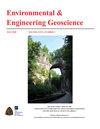Composting of fine fraction after mechanical-biological treatment of municipal solid waste
IF 1
4区 工程技术
Q4 ENGINEERING, ENVIRONMENTAL
引用次数: 0
Abstract
One of most common types of municipal solid waste treatment is mechanical-biological treatment (MBT), which in practice has many variations depending on the method of conducting the technological process and it is possible to get different output fractions. In this paper is analysed waste generated after the MBT with biodrying, where waste after mechanical treatment undergoes process of biodrying, and then is RDF (recovery derived fuel) separated. Fine fraction remains with a high content of organic matter that without additional processing cannot be disposed of on a landfill. The aim of this research was to determine the possibility of fine fraction composting in different conditions – in the open, in the open and covered area, and indoors. In each area are formed three compost piles: 100% fine fraction (KH1, KH4, and KH7), 70% fine fraction and 30% wood chips (KH2, KH5, and KH8), 50% fine fraction and 50% wood chips (KH3, KH6, and KH9). Moisture content, temperature and dissolved organic carbon (DOC) were monitored. Results show that after 13 weeks samples KH1, KH4, and KH7 (100% content of fine fractions) did not achieve DOC value less than 3 000 mg/l. The most effective composting in terms of reducing the DOC is achieved in samples KH3, KH6, KH9. Based on results obtained, it can be concluded that by adding wood chips in fine fraction in ratio 50:50, the most effective and fastest reduction of organic matter is achieved in the analysed samples.城市生活垃圾经机械-生物处理后的脱碱馏分堆肥
最常见的一种城市生活垃圾处理方法是机械-生物处理(MBT),它在实践中有许多变化,这取决于进行工艺过程的方法,并有可能得到不同的输出分数。本文对MBT生物干燥后产生的垃圾进行了分析,其中机械处理后的垃圾进行生物干燥,然后分离出RDF(回收衍生燃料)。残留的有机物含量很高,如果没有额外的处理,就不能在垃圾填埋场处理。本研究的目的是确定在不同条件下进行细粒堆肥的可能性-在露天,露天和有盖区域,以及室内。每个区域形成3个堆肥堆:100%细粒堆(KH1、KH4和KH7)、70%细粒堆和30%木屑堆(KH2、KH5和KH8)、50%细粒堆和50%木屑堆(KH3、KH6和KH9)。水分含量、温度和溶解有机碳(DOC)进行了监测。结果表明,13周后,样品KH1、KH4和KH7(100%细馏分含量)的DOC值均未达到3 000 mg/l以下。在减少DOC方面,最有效的堆肥是在样品KH3, KH6, KH9中实现的。结果表明,以50:50的比例加入细粒木屑,对分析样品中有机物的还原效果最好,速度最快。
本文章由计算机程序翻译,如有差异,请以英文原文为准。
求助全文
约1分钟内获得全文
求助全文
来源期刊

Environmental & Engineering Geoscience
地学-地球科学综合
CiteScore
2.10
自引率
0.00%
发文量
25
审稿时长
>12 weeks
期刊介绍:
The Environmental & Engineering Geoscience Journal publishes peer-reviewed manuscripts that address issues relating to the interaction of people with hydrologic and geologic systems. Theoretical and applied contributions are appropriate, and the primary criteria for acceptance are scientific and technical merit.
 求助内容:
求助内容: 应助结果提醒方式:
应助结果提醒方式:


